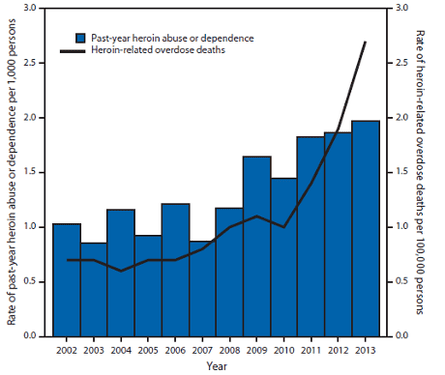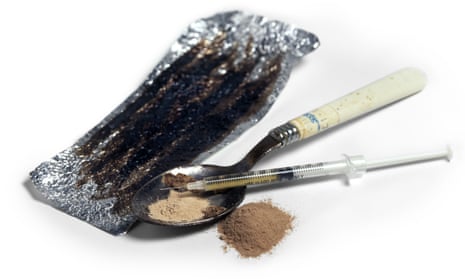Heroin-related overdose deaths in the US have nearly quadrupled since 2002 and use of the drug has increased by 63%, according to a newly released report from the Centers for Disease Control (CDC) that sheds light on a growing epidemic.
“Over the past decade, we have found a significant increase in heroin use across almost all demographic groups,” said Dr Christopher M Jones, senior adviser at the Food and Drug Administration (FDA) and co-author of the report. But the greatest increases were seen among “populations who historically had lower rates of heroin use”, he added. Heroin use among women doubled between 2002 and 2013, the period of study, while use among non-Hispanic whites more than doubled.
Nearly all (96%) of those who had reported using heroin in the past year also reported using at least one other drug, with a majority (61%) reporting concurrent use of three or more substances, according to the report.
“In this context, it’s really a poly-substance abuse issue,” Jones said.
The highest rate of heroin use was “consistently found among users of cocaine”, the report noted, but the largest increase in use over the study period was seen among users of opioid pain relievers. Opioid pain reliever abuse or dependence was also more commonly associated with heroin use.
Increasing heroin dependence is closely tied to prescription pain reliever abuse, said Dr Jay Unick, associate professor at the University of Maryland School of Social Work and author of a 2013 study on trends in heroin- and opioid-related overdoses.
“A decade and a half ago we saw a real surge in the availability of prescription opiate drugs in the US [and a] dramatic increase in the number of people using opiates,” Unick said.
At the same time, there has been a surge in heroin production and trafficking from Mexico. Heroin seizures by federal and local law enforcement have increased nearly 300% since 2007, according to a report on heroin abuse from the Pew Charitable Trusts.

“When you have a population of people with a real affinity for opiates, and a new, cheap, widely available opiate on the market, it’s not surprising that we see a lot more people using heroin,” Unick said.
Evidence from both Unick’s research and the new CDC report suggests that heroin and prescription pain reliever use has a strong positive relationship. People tend to use the drugs interchangeably, depending on economics, both Unick and Jones noted.
“There is evidence that as you increase the number of people addicted to opiates, either prescription drugs or heroin, you see more use of the other one. That’s why we refer to this as an intertwined epidemic. These things are feeding on each other,” Unick said.
That’s also why the CDC report recommended a specific focus on both heroin and opioid pain reliever abuse as part of a comprehensive strategy to reduce abuse and dependence on the drugs.
“Improving how opioids are prescribed and identifying problematic use early on and connecting people with treatment” could help reduce initiates to heroin, Jones said.
But, he added, “we also have this large cohort of people who are already addicted to heroin or prescription opiates, and that’s where medication-assisted treatment comes in”. Wider availability of such treatment options has been shown to reduce drug use, overdose and related high-risk behaviors, such as injection drug use which can lead to HIV and hepatitis C transmission, Jones said.
A third recommendation called for expanding access to naloxone, a drug which can revive patients from opiate-induced overdose, to help address skyrocketing overdose deaths.
The new report’s recommendations echo those from a US Department of Health and Human Services initiative aimed at addressing opioid-related dependence launched earlier this year.

Comments (…)
Sign in or create your Guardian account to join the discussion